Turkic history
This article has multiple issues.Please helpimprove itor discuss these issues on thetalk page.(Learn how and when to remove these template messages)
|
| History of the Turkic peoplespre–14th century |
|---|
 |
Turkichistoryis the systematic documentation and study of events involving theTurkic peoples.
Origins
[edit]Turks were an important political identity ofEurasia.They first appeared atInner Eurasiansteppesand migrated to many various regions (such as Central Asia,West Asia,Siberia,and Eastern Europe.) and participated in many local civilizations there. It is not yet known when, where, and how the Turks formed as a population identity. However, it is predicted thatProto-Turkic populationshave inhabited regions that they could have the lifestyle ofEurasianequestrianpastoralnomadic culture.[1]
Türkwas first used as a political identity in history during theGöktürk Khaganateperiod.[2]Theold Turkic scriptwas invented byGöktürksas well.[3]The rulingAshina clanorigins are disputed.[4]

Although there are debates about its inception, the history of the Turks is an important part ofworld history.The history of all people that emerged inEurasiaand North Africa has been affected by the movements of the Turks to some degree. Turks also played an important role in bringingEastern culturesto the West andWestern culturesto theEast.Their own religion became the pioneer and defender of the foreign religions they adopted afterTengrism,and they helped their spread and development (Manichaeism,Judaism,Buddhism,Orthodox,Nestorian ChristianityandIslam).
The beginning of Turkic history
[edit]3rd century BC
[edit]- 240 BC:Great Wall of China started to be built to protect the nation againstInner Asian nomads.
- c. 202 BC:XiongnuchanyuModu conquered the Hunyu ( hồn dữu ), Qushe ( khuất bắn ),Dingling( leng keng ), Gekun ( cách côn ), and Xinli ( tân lê );[5]The Gekun and Xinli would later appear among the Turkic-speakingTiele people,respectively, asHegu[6]andXue.[7][8]TheDinglingwere also proposed to be early Proto-Turkic people[9][10]or ancestors ofTungusic speakersamong theShiwei.[a][12][13]or related toNa-DenéandYeniseianspeakers,[14]

4th century
[edit]- 395:Migration Period
5th century
[edit]- 461:Sabir peoplearoundSiberia
- 480:Pre-Bulgariansbetween theCaspian Seaand theDanube
Middle Ages/Turks
[edit]6th century
[edit]
- 540:The re-emergence of the lost Central Asian Turks mentioned in theErgenekon epic[15]
- 540:SasanianKing of Iran,Hormizd IV,born to aKhazarPrincess mother who married to theKhosrow I
- 551:Establishment of theFirst Turkic Khaganate.
- 552:Göktürksrevolt againstRourandomination.
- 565:Defeat of theHephthaliteson their war withGöktürks.
- 567:Western Turkic Khaganateambassador Maniakh sent byIstämitoConstantinople.
- 567:Establishment of thePannonian Avars.
- 568:Zemarchus,a Byzantine diplomat, sent to theGöktürksEmpire.
- 582:Separation of theFirst Turkic Khaganate.

7th century
[edit]Central Asia
[edit]- 625:Establishment ofTokhara Yabghus.
- 630:Eastern Turkic Khanatecame under Chinese domination,Western Turkic Khanatecame under Chinese influence.
- 639:TurkicprinceAshina Jiesheshuai's attempt on a Turkic revolt in the Chinese emperor's palace.
- 659:Western Turkic Khaganatecame under Chinese rule.
- 665:Establishment ofTurk Shahis.
- 674:The appearance of Turkic mercenaries (Mamluks) inArabarmies.
- 681:Second Turkic Khaganateestablished.
- 699:The establishment of theTurgesh Khanate(in present-dayKyrgyzstan)
Eastern Europe
[edit]- 626–627:Eastern Roman EmperorHeraclius' request for help from theKhazars,theKhazars' invasion of theCaucasusby defeating theSassanidsafterthe Sassanids and Pannonian Avars besieged Constantinople
- 630:Khazars' settlement in theDon-Volgabasin, which was affiliated to theWestern Turkic Khaganate,and the establishment of theGreat Bulgarian Khanatein the north of theBlack Sea.
- 651–652:War of theArab Empireand theKhazars,who overthrew theSassanidsand captured all ofIran
- 678:The division of theGreat Bulgarian Khanateby the westward pressure of theKhazars
8th century
[edit]Inner Asia
[edit]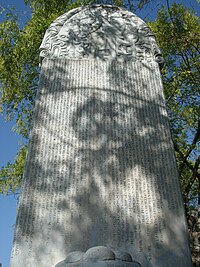
- 705–715:Arabs takeTransoxiana
- 720–735:Orkhon MonumentsinÖtüken
- 721–737:Turgeshattack against Arabs
- 744:The destruction of theSecond Turkic Khanateby the rebelliousUyghurs,KarluksandBasmyls
- 745:Establishment of theUyghur Khaganate,independent khanate ofKimeksin what is todayKazakhstan
- 750:The strengthening ofArab-Turkicrelations after theAbbasidscame to the head of the Arab Empire
- 751:The entry of the Chinese into Central Asia, the defeat of the Chinese by the Arabs with the help of theKarluksin theBattle of Talas,the conversion of theKarlukstoIslam
- 762:Uyghur KhaganateaidedTang dynastyin China in suppressing theAn-Lu-Shan uprising
- 765:Adoption of theMani religionby theUyghur Khan Bögü
- 766:The dissolution of theTürgesh Khanateby theKarluksof theUyghur Khanate,the establishment of the autonomousKarluk Khanate,the laying of the foundations of theOghuz Yabgu Stateby theOghuzeswho escaped from theKarluksand migrated to the vicinity of theCaspianandArallakes.
- 789–795:Fight for the throne and decline in theUyghur Khaganate
Eastern Europe
[edit]- 705:Theodora of Khazaria,a Khazar princess and Byzantine empress as the second wife ofJustinian II
- 713–737:Khazar-Arab War,Khazarloss ofCaucasus
- 716:The first written agreement of theDanube Bulgarian Khanatewith theByzantine Empireand the start of taxation
- 717–718:Aid of theBulgarianstoByzantiumagainst theArab Siege of Constantinople
- 740:Adoption of Judaism as the official religion of theKhazars
- 741:Tzitzak,aKhazarprincess, Empress of the Byzantine Empire by marriage to Eastern Roman EmperorConstantine V.Mother of Byzantine emperor,Leo IV the Khazar
- 745–775:Bulgarian-Byzantine relations tense
- 764:Invasion of theCaucasusandwestern Iranby theKhazars,defeating theAbbasids
- 780:Founding ofVolga Bulgaria
- 792:After theBattle of Markeli,Byzantiumbegan to pay taxes to theBulgariansagain.
- 795:Bardanes Tourkos,a Byzantine general of Khazar-Armenian descent who launched an unsuccessful rebellion against Emperor Nikephoros I
9th century
[edit]
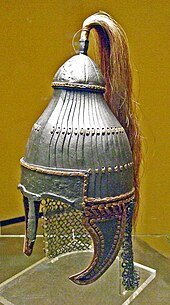
Central Asia
[edit]- 821:UighursrepulseTibetans
- 832:TheUighur Khaganateplunged into turmoil
- 840:The collapse of theUyghur Khaganateas a result of the attack of theKyrgyz people,the establishment of theKyrgyz Khaganate,the escape of theUyghursto the southwest, theKarluks,who did not recognize theKyrgyzsovereignty, declared their independence and laid the foundation of theKarakhanid State.
- 848:The establishment of theGanzhou Uyghur Kingdomof theUyghurswho migrated to the South West
- 856:The establishment of theKarahoca Uyghur Kingdomby anotherUyghurbranch that migrated to the southwest.
Eastern Europe
[edit]- 860:The Russians, who expanded to the south, reachedKievin theKhazar Khaganate.
- 861:Migration ofPechenegsaroundSri Daryato the north of theBlack Seaunder the pressure ofOghuzes,KimeksandKarluks
- 880:The formation of theKimek–Kipchak confederation
- 889:The advance of thePechenegsin the north of theBlack Seato the west under the pressure of theKhazarsandKipchaks
- 892:ThePechenegsadvancing to the west forced theHungariansfrom theDnieperto migrate beyond theCarpathians,forming an agreement with theByzantine Empire.
Asia and Africa
[edit]- 833–842:The increasing influence ofTurkic slave soldiersin theAbbasidpalace duringCaliph Mutasim's reign
- 836:The relocation of theAbbasidcapital fromBaghdadtoSamerra,where theTurkic slave garrisonwas located
- 868:Tulunidsovereignty overEgypt,Syria,Palestineand the north ofIraqbut still remain within theAbbasid Caliphate
10th century
[edit]Central Asia
[edit]- 923:The establishment of theLater Tang dynastyby theShatuo Turks,descended from theGöktürks,in the north of China
- 924:The destruction of theKyrgyz Stateby theMongol Khtai,the end of the Turkic rule inÖtüken,the migration of theKyrgyzto their present homeland.
- 934:WithSatuk Buğra Khan's acceptance ofIslam,theKarakhanid Stateadopt the religion ofIslam
- 979:TheShatuo Turkscame under the domination of the Han Chinese NorthernSong dynasty,the Shatuo flee to Inner Mongolia where they come theOngudTurks.[17][18]The Ongud assimilated to the Mongols.[19][20][21][22]
- 990–999:TheKarakhanid Statedestroyed theSamanid Empire,Transoxianacame under Turkic rule after 300 years.
Eastern Europe
[edit]- 920:Russo-Pecheneg War
- 922:Visit ofIbn Fadlanas ambassador to theBulgarian Khanate of İdil,which converted to Islam
- 940:Russian-Byzantine alliance againstKhazars,KhazarsloseCrimea
- 943:Pechenegsallied with theRussiansagainst theByzantine Empire
- 965:Oghuz Yabgu State's alliance with theRussiansagainst theKhazars
- 968–972:Pechenegs' attacks on theRussians
- 969:The capture of theKhazarcapital by the Russian kingSvyatoslav I,the withdrawal of theKhazarsto the north of theCaucasus
- 985:Oghuz Yabgu State's alliance with theRussiansagainst theVolga Bulgarian State
- 986:Settlements of theSeljuksin the south ofKazakhstanby breaking away from theOghuz Yabgu State
Asia and Africa
[edit]- 905:The end of theTuluniddynasty inEgyptby theAbbasids
- 935:AnotherTurkicdynasty, theIkhshidid dynasty,seized power inEgyptand dominatedSyria,Palestine,Hejazand northernSudan.
- 977:Sabuktigin establishsGhaznavid dynastyin Khorasan(modern-dayAfghanistan)
- 969:Termination of the rule of theIkhshidid dynastyby theFatimid State
11th century
[edit]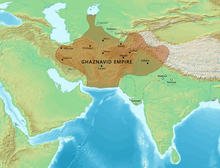

Central Asia
[edit]- 1030:Ghaznavid Empire reaches to its greatest extent underMahmud of Ghazni.
- 1036:TheKansu Uyghur Kingdomcame under the rule of the MongolianTankut Kingdom.
- 1042:The division of theKarakhanid Stateinto East and West
- 1050:The destruction of theKimek Khanateby the invasion of theKipchaks
- 1089:Samarkand-centered Western Karakhanid State entered theSeljuknationality
- 1091:The Eastern Karakhanid State, based inKashgar,became subject to theSeljuks.
- 1092:As a result of theGreat Seljuk Statebeing dragged into internal turmoil, the two Karakhanid states became independent again.
Eastern Europe
[edit]- 1016:The destruction of theKhazar Khaganateby theRussiansand theByzantine Empire
- 1037:Settlement ofPechenegsdefeated by theRussiansin Romania
- 1061–1068:TheKipchaks,who defeated theRussians,captured the north of theBlack SeaandUkraine
- 1091:After theBattle of Manzikert,thePechenegs,who attacked theByzantine Empire,which was in turmoil, were destroyed by the Byzantine-Kipchak alliance aroundEnez.
- 1093:Cuman–Kipchak Confederationdecisive defeat of theKievan Rus'at theBattle of the Stuhna River.[b][24]
Asia
[edit]- 1038:Establishment of theSeljuk StateinKhorasan.
- 1040:In theBattle of Dandanaqan,theSeljuksdefeated theGhaznavidsand spread towardsPersia.
- 1048:TheSeljuks,who defeated the Byzantine-Georgian alliance at theBattle of Kapetron,enteredEastern Anatolia.
- 1055:SeljuksconquerBaghdadand seize theAbbasid Caliphate.
- 1056:Sejuk princess,Khadija Arslan Khatun,married to the Abbasid Caliph,Al-Qaim.
- 1063:Abbasid princess, Sayida Khatun, daughter of Abbasid CaliphAl-Qaimmarried to the Seljuk Sultan,Tughril I.
- 1064:SeljuksconquerAniCastle and break the Armenian-Georgian resistance
- 1071:TheOghuzTurcomanswho have defeated theByzantine Empireat theBattle of Manzikert,started settlements atAnatolia.[citation needed]
- 1071:Sifri Khatun,Seljuk princess, daughter of sultanAlp Arslanmarried to the Abbasid caliph,Al-Muqtadi.
- 1072:Establishment ofDanishmend PrincipalityinSivasas subordinate toGreat Seljuks
- 1077:Establishment of theSeljuk Sultanate of Rûmwhose capital isIznikas subordinate to theGreat Seljuks.
- 1081:The construction of the navy on theAegeancoast of the Çaka Principality and the establishment of theTurkish Naval Forces
- 1085:Establishment of the Syrian Seljuk State.
- 1087:Mah-i Mulk Khatun,Seljuk princess, daughter ofMalik-Shah Imarried to the Abbasid caliph,Al-Muqtadi.Abbasid and Seljuk Prince, Ja'far ibn Abdallah al-Muqtadi, was born from this marriage.
- 1092:As a result of the murder ofSultan Melikşahby theOrder of Assassins,theGreat Seljuk Statewas dragged into internal turmoil
- 1096:The destruction of the pioneers of theFirst Crusadeby theAnatolian Seljuk StateinIznik
- 1096–1099:As a result of theFirst Crusade,IznikandWestern Anatoliawere taken back byByzantium,andCrusader stateletswere formed on the Syrian andPalestiniancoasts.
South Asia
[edit]- 1001–1027:The expeditions ofMahmud of Ghazni,the ruler of theGhaznavids,in Indian subcontinent resulted in the spread of Turkic sovereignty andIslamto the north of India
- 1037–1059:The struggle of theGhaznavidswith theSeljuk Empireresulted intoKhorasanandIranbeing dominated by theSeljuks
- 1059:Peace treatybetweenGhaznavidsandSeljuks
- 1079–1080:Ghaznavids's defeat of theGhurid dynasty,which gained power inAfghanistan
12th century
[edit]Asia
[edit]- 1100:TheDanishmendsdefeated thePrincipality of AntakyainMalatyaand definitively stopped theCrusaders' advance toSoutheastern Anatolia.
- 1101:The defeat of theAnatolian Seljuk Stateand theDanishmendsby the Crusaders inKastamonuandMerzifon
- 1104:TheGreat Seljuk Statedefeated the Crusaders inHarranand blocked their advance to theEuphrates.
- 1104:Establishment ofBörüoğulları AtabeyinDamascus
- 1105–1128:Seljuks struggle against the Crusaders inSyria,the resistance ofDamascusandAleppoto the Crusader sieges
- 1108:Seljuk princess,Ismah Khatun,married to the Abbasid Caliph,Al-Mustazhir.
- 1124:Seljuk princess,Amira Khatun,married to the Abbasid Caliph,Al-Mustarshid.
- 1127:Establishment ofZengi AtabeylikinMosul
- 1127–1174:The struggle of theZengid's with the Crusaders
- 1137:Seljuk princess,Fatimah Khatun,married to the Abbasid Caliph,Al-Muqtafi.
- 1140:Abbasid princess, Zubaydah, daughter ofAl-Muqtafimarried to the Seljuk Sultan,Ghiyath ad-Din Mas'ud.
- 1144:The conquest ofUrfaby theZengid's
- 1144:Establishment of Beytegin Atabeylik inErbil
- 1147–1149:Organized after the fall ofUrfa,in theSecond Crusade,theAnatolian Seljuk Statedefeated the Crusaders' German army inEskişehirandLadik,theZengid's repelled the Crusaders'Siege of Damascus
- 1150:The elimination of theUrfa County,one of the four Crusader states, by theZengids
- 1154:Elimination of theBörioğulları Atabeyby theZengids
- 1158:Abbasid princess,Kerman Khatun,daughter ofAl-Muqtafi,married to the Seljuk Sultan,Muhammad II ibn Mahmudand then another Seljuk Sultan,Arslan-Shah.
- 1173–1178:TheAnatolian Seljuk Statebecame the only power inAnatoliaby capturing all the lands of theDanishmends.
- 1174–1183:Salahaddin Ayyubi's EndingZengidsovereignty inSyria
- 1176:The defeat of theByzantinesby theAnatolian Seljuk Statein theBattle of Myriokephalon,the finalization of theSeljuksovereignty inAnatolia
- 1186:Seljuk princess,Seljuki Khatunmarried to the Abbasid Caliph,al-Nasir.
- 1190:The invasion ofKonyaby the German arm of the Crusaders in theThird Crusade,the disintegration of the German army after the drowning of the German EmperorFrederick BarbarossainSilifke
- 1192:Seljuk Sultan,Kaykhusraw Imarried to Dawlat Raziya Khatun, daughter ofManuel Maurozomes,a Byzantine nobleman.
Iran and Central Asia
[edit]- 1092–1118:Internal turmoil and emergence of semi-independent atabeyliks within theGreat Seljuk State
- 1132:The MongolianKarahitaysstarted to move towards Turkic lands by eliminating theQocho.
- 1134:Karahitaysoverthrow the Eastern Karakhanids
- 1137:Karahitaysoverthrow the Western Karakhanids and demolish their dominance in Central Asia
- 1141:The collapse of theGreat Seljuk State,which was defeated by theKarahitaysin theBattle of Qatwan
- 1154–1157:Dissolution of theGreat Seljuk Stateafter the rebellion of theOghuzs,the independence of theKhorezmshahs State
- 1182–1194:TheKhwarazmshahsconqueredTransoxianaby defeatingIran,KhorasanandKarahitays
- 1188:The elimination of theKerman Seljuk State,one of the successors of theGreat Seljuk State,by theOghuzes
- 1194:The abolition of the Iraqi Seljuk State, one of the successors of theGreat Seljuk State,by theKhwarazmshahs State.
South Asia
[edit]- 1135:The Seljuk army re-enteringGhazniand ta xing theGhaznavidsagain
- 1148–1151:Great destruction caused by theGhuridsafter capturingGhazni
- 1152:Seljukscapture ofGhaznifromGhurids
- 1157–1163:With the disintegration of theGreat Seljuk State,GhazniandAfghanistanfell back into the hands of theGhurids.
- 1186:The conquest of theGhaznavid State,which continued to dominatePunjab,withLahoreas its capital, caused by theGhurids.
Eastern Europe
[edit]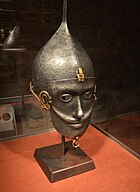
- 1111–1116:Kipchaktribes defeated by theRussians
- 1123:Georgianssupported byKipchaksexpelGreat Seljuksfrom Tbilisi
- 1150:The Kipchaks regain their strength in theDnieper.
- 1154:The Kipchaks, who repulsed theRussians,re-established their dominance aroundKharkiv.
- 1157–1174:Conflicts betweenVolga BulgarianandRussians
- 1174–1185:Military successes of theKipchaksagainst theRussians
- 1200:The dissolution of theKimek–Kipchak confederation
13th century
[edit]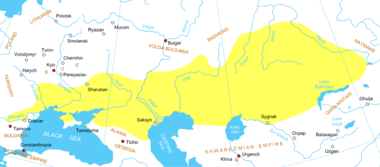
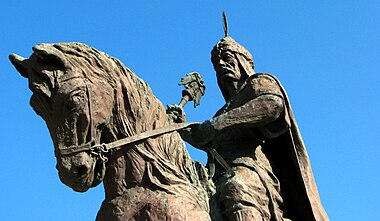
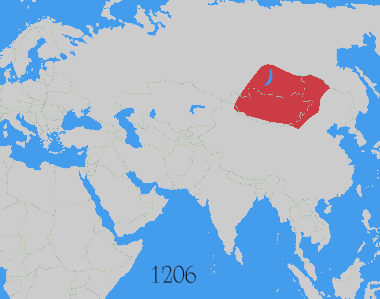
Asia and the Middle East
[edit]- 1202:The expansion of theAnatolian Seljuk StatetoEastern Anatoliaby eliminating theSaltuklu Principality
- 1207:The opening of theAnatolian Seljuk Stateto theMediterraneanwith the conquest ofAntalya
- 1214:The opening of theAnatolian Seljuk Stateto theBlack Seawith the conquest ofSinop
- 1228:Elimination of theMengüçlü Principalityby theAnatolian Seljuk State
- 1230:TheKhorezmshahs,who escaped from theMongol invasionand advanced toAnatolia,were stopped by theAnatolian Seljuk Statein theBattle of Yassıçemen
- 1239:Therevolt of Baba İshakweakened theAnatolian Seljuk State.
- 1243:The defeat of theAnatolian Seljuk Stateby theMongolsin theBattle of Kösedağ
- 1250:The seizure of power by the Turkish-originMamluk Sultanatein Egypt, putting an end to theAyyubids
- Nureddin Beylaid the foundations of the principality inKaraman
- 1299:Founding of theOttoman State
Central Asia
[edit]- 1212:The elimination of theKarakhanids,who ruled inFergana,by theKhwarazmshahs State.
South Asia
[edit]- 1206:Establishment ofDelhi Sultanateby Turkic-origin slave commanders
- 1236:Delhi Sultanate's dominance of all ofnorthern India,KashmirandBangladesh
- 1290:Turko-Afghan-originKhalji dynastyseized power in theDelhi Sultanate
14th century
[edit]- 1320–1424:Tughluk Dynastyin Delhi established and ruled most of the India.
- 1346:TheOttomansentered Europe.
- 1361:Conquest of Edirneby theOttomansoccurred.
- 1370:TheSalarsare descended from Turkmen who migrated from Central Asia and settled in a Tibetan area of Qinghai under Ming Chinese rule. The Salar ethnicity formed and underwent ethnogenesis from a process of male Turkmen migrants from Central Asia marryingAmdoTibetanwomen during the early Ming dynasty.[25][26][27][28]
- 1370:Timur's seizure of power, establishment ofTimurid Empire.
- 1382:Tokhtamyshleads theGolden Horde's Army and setsMoscow on fire.
- 1389:Battle of Kosovo:Ottomandomination in the Balkans
- 1389–1403:Reign ofBayezid
- 1398:Timur'smilitary expedition to India
15th century
[edit]Asia
[edit]- 1402:Battle of AnkarabetweenTimurandBayezid I
- 1406:Re-emergence ofAkkoyunluandKarakoyunlupeople on the stage of history
- 1453:Conquest of IstanbulbyMehmed the Conqueror
- 1453–1504:The golden age of theAkkoyunlu state.
Central Asia
[edit]- 1405:Timur's death
- 1405–1447:Arrival ofShahruhinHerat
- 1447–1449:Ulugh Beg
- 1456:Establishment of theKazakh Khanate
Eastern Europe
[edit]- 1430:Crimean Khanateformed
- 1445:Establishment of theKhanate of Kazan
- 1462–1505:Astrakhan Khanate,Kazakh khanatecreated
- 1473:Sultan Husayn Bayqara:Timurid Renaissance
Modern era (1500 AD – present)
[edit]16th century
[edit]Eastern Europe
[edit]- 1502:TheCrimean Khanate's destruction of theGolden Hordestate
- 1552:Russia's annexation of theKazan Khanate
- 1556:The annexation of theAstrakhan Khanateby Russia
- 1557:Russia's annexation of theNogai Khanate
- 1571:Crimean Khanateburns Moscow
- 1580–1598:Russia's elimination of theSiberian Khanate
Central Asia
[edit]- 1500:Muhammed ShaybaniandUzbeksinTransoxiana
- 1510:The defeat ofMuhammed ShaybanibyShah Ismail
Asia
[edit]- 1502:Ismail's establishment of theSafavid dynastyin Iran
- 1514:TheBattle of Çaldıran,the settlement of theOttomansinEastern Anatolia
- 1516:Battle of Ridaniye,OttomanstakingSyriaandPalestinefrom theMamluk State
- 1517:Ottomandomination inHijaz
- 1534:OttomanstakingIraqfromSafavids
- 1538:Ottomandomination inYemen
- 1551:Ottomanrule reachingQatarandOman
- 1578:Ottomansreaching theCaspian Sea
- 1590:Ottomanconquest of the entireCaucasusandWestern Iran
South Asia
[edit]- 1526:Establishment of theMughal Empire
Africa
[edit]- 1516:Establishment ofOttomanadministration inAlgeria
- 1516–1517:The Ottomans' destruction of the Mamluk State, Ottomandomination inEgypt
- 1551:Beginning ofOttomanrule inLibya
- 1557:Establishment of theAbyssinian Provinceby theOttomans
- 1574:Beginning ofOttomanrule inTunisia
- 1577:The spread ofOttomanrule inFezzan
- 1576–1580:Ottomaninfluence inMorocco
17th century
[edit]Eastern Europe
[edit]- 1600:The defeat of theSiberian Khanate.
- 1606:TheTreaty of Zitvatorok,which symbolized theOttoman Empire's peak
- 1683:Siege of Viennaby theOttomans.
- 1699:Treaty of Karlowitz.The decline of theOttomans.
Asia
[edit]Central Asia
[edit]- 1605:Russian invasion ofYenisey
- 1615–1650:The struggle of theYenisei Kyrgyzpeople against theRussians
- 1620:Russia's annexation ofYakutlands
- 1628:Dolgan'sdomination by Russia
- 1628–1630:AnotherMongoliantribe, theKalmyks,who were defeated by the Eastern Mongols, trampled onKazakhstanand settled in theVolgaregion.
- 1634–1642:Russia's suppression of theYakutrevolts
- 1639:Russia's Reaching the Pacific Ocean
- 1680:MongolcaptureEast Turkestan,end ofChagatai Khanate
South Asia
[edit]- 1628–1658:Shah Jahan,emperor of India.
- 1658–1707:Aurangzeb,emperor of India.
18th century
[edit]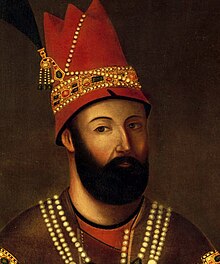
Eastern Europe
[edit]- 1742–1775:Pugachev Warin Russia (Tatar uprising)
- 1783:Annexation ofCrimeaby theRussians.
Asia
[edit]- 1717–1730:Tulip Eraof theOttomans.
- 1736–1747:Nader ShahofTurkomanorigin establishedAfsharid Empire,owning the identity of TurkicAfshar tribes.
- 1794:Qajar dynastyfounded inIranby aTurk.
Central Asia
[edit]- 1709:Establishment ofKokand Khanate
- 1709–1718:TheDzungarian-Kazakh KhanateConflict
- 1718:The division of theKazakh Khanateinto three kingdoms.
- 1721:Russia's annexation ofKhakassia
- 1731:The minor part of theKazakh Khanatecame underRussianprotection.
- 1740–1747:Iranian domination in theKhiva Khanate
- 1755–1759:TheManchu Dynasty,which took over the administration in China, seizedEast Turkestanwhich was in the hands of theDzungarians
- 1755:Tuvaunder the rule of theManchu Dynasty,which seized power in China
- 1756:Russia's capture of theAltairegion
- 1785:Manghud's takeover of theBukhara Khanate
Africa
[edit]- 1705:TheHuseyni Dynastyappointed inTunisia,which was a part of theOttoman Empire
- 1798–1799:Egyptexpedition ofNapoleon Bonaparte.Turkish-French conflicts.
19th century
[edit]Eastern Europe
[edit]- 1829:Greece's independence
- 1878:Treaty of Berlin,Serbia,Montenegro,Romaniagaining their independence,Bulgariagaining autonomy
- 1881:Greek annexation ofThessaly
- 1881:Atatürk's birth
- 1885:Bulgaria's annexation ofEastern Rumelia
- 1813:Russia's annexation ofDagestanandAzerbaijan
- 1827:Russian domination of theBalkars
- 1828:Karachays' entry into Russian domination
- 1828:Russia's annexation ofYerevanandNakhchivan
- 1829:Russia's annexation ofAkhaltsikhe
- 1839:Tanzimat Edictin theOttoman Empire
- 1876:The first constitution of theOttoman Empirelegislated.
Central Asia
[edit]- 1820:TheGreat Juzof theKazakh Khanatecame under the rule of theKokand Khanate
- 1847:The lands of theKazakh Khanatecompletely passed into the hands of Russia
- 1851–1854:The defeat of theKhiva Khanateto theRussians
- 1864:The start of Russian expeditions toWest Turkestan
- 1865:Establishment of Kashgar Khanate inEast Turkestan
- 1866:TheEmirate of Bukharacame under Russian rule
- 1868:TheKokand Khanatecame under Russian rule
- 1871:Russian occupation ofLake Balkhash
- 1873:TheKhiva Khanatecame under Russian rule
- 1876:Russia's annexation of theKhanate of Kokand
- 1877–1878:China's elimination of the Khanate of Kashgar
- 1881–1884:Russia's annexation ofTurkmenistan
South Asia
[edit]- 1805:TheMughal Statecame under the auspices of theBritishwho defeated theMaratha Confederation
- 1857:TheBritishoverthrow theMughal State
Africa
[edit]- 1807:Britishabolishslave trade,Royal Navypatrol around Africa to intercept slave ships
- 1822:Sudan's entry intoOttomanrule
- 1830–1842:French invasion ofAlgeria
- 1831–1840:Ottoman-Egyptian struggle,Egyptgaining autonomy
- 1869:Opening of theSuez Canal
- 1881:SecondFrench invasion of Algeria
- 1882:Britishinvasion ofEgypt
- 1885:Italian invasion ofHabesh
- 1885:End of Turkish rule inSudan
- 1888:Britishinvasion ofSomalia,end of Turkish presence inHorn of Africa
20th century
[edit]- 1905:Beginning ofJadidism movements.
- 1910–1920:Alash Horda GovernmentofKazakhsandKyrgyz
- 1911–1912:Invasion ofTripoliby Italy
- 1912:Balkan wars
- 1915–1916:Gallipoli campaign
- 1917:Turkistan's declaration of autonomy
- 1918:TheArmistice of Mudroswas signed betweenTurkeyand theAllied Powers.
- 1918:Establishment ofAzerbaijan Democratic Republic.
- 1919–1922:TheTurkish War of Independencetook place.
- 1919–1928:Basmachi Uprisingagainst theSoviet Union
- 1921–1944:Tuvan People's Republic
- 1922:Turkish victory overGreeks
- 1923:Turkeyproclaimed to be a Republic
- 1932–1934:East Turkestan Islamic RepublicofUyghursin China
- 1938:Ataturk's death
- 1944:Short-livedEast Turkestan Republicestablished with the help of the Russian army
- 1955:Xin gian g Uyghur Autonomous Region:DeclaringXin gian g(East Turkistan) an autonomous region
- 1971:European withdrawal from Central Asia
- 1974:Turkish invasion of Cyprus
- 1983:The declaration of independence of theTurkish Republic of Northern Cyprus
- 1988:The beginning of the Azeri-Armenian conflict
- 1990:Soviet invasion ofBaku
- 1991:The collapse of theUSSRand the emergence of theCommonwealth of Independent States
- 1992:Admission of theCISTurkic republics to the UN:
- 1992:The first Turkic Speaking Countries Summit was held inAnkaraon 30 October 1992.
- 1993:The occupation of a region ofAzerbaijanby theArmenians.
- 1993:In 1993, the Turkish Culture and Arts Joint Administration was established inAlmaty,which provides cooperation in the fields of culture and arts of Turkic Speaking Countries.
- 1993:The first Turkic Congress, which was a cultural, economic and political forum and was attended by all Turkic states and communities and related communities.
21st century
[edit]- 2005:Tulip Revolutionin Kyrgyzstan.
- 2005:Kazakh leaderNursultan Nazarbayev's proposal to establish a common market in Central Asia in his address to the nation.
- 2005:Andijan massacrein Uzbekistan
- 2006:Baku-Tbilisi-Ceyhan pipelineput into service.
- 2007:The first meeting ofripariancountries to determine the status of theCaspian Sea.
- 2008:Establishment of theParliamentary Assembly of Turkic Speaking CountriesbetweenTurkey,Azerbaijan,KazakhstanandKyrgyzstanon 21 November 2008.
- 2009:Establishment ofOrganization of Turkic States.
- 2013:Gezi Park protests
- 2016:Turkish coup attemptbyPeace at Home Council[29]

Notes
[edit]- ^Shiwei were stated in most Chinese sources (e.g.Weishu100,Suishu84,Jiu Tangshu199) to be relatives to para-Mongolic-speakingKhitans;the sub-tribe Mengwu Shiwei mông ngột thất Vi were identitied as ancestors and namesakes of theMongols[11]
- ^Curta states "The Cumans defeated Sviatopolk II, grand prince of Kiev in 1093 and took Torchesk."[23]
Turkish books
[edit]- İbrahim Kafesoğlu,Türk Millî Kültürü,Ankara, 1983.
- Zeki. Velidi Togan,Umumi Türk Tarihine Giriş,İstanbul, 1970.
- Faruk Sümer,Oğuzlar,İstanbul, 1980.
- Bahaeddin Ögel,İslamiyetten Önce Türk Kültür Tarihi,Ankara, 1962.
- Bahaeddin Ögel,Türk Kültür Tarihine Giriş,İstanbul, 1978.
- Bahaeddin Ögel,Büyük Hun İmparatorluğu Tarihi,Ankara, 1981.
- Çeçen Anıl,Tarihte Türk Devletleri,İstanbul, 1986.
- O. Esad Arseven,Türk Sanat Tarihi,İstanbul, 1955.
- Muharrem Ergin,Orhun Abideleri,İstanbul, 1977.
- Erol Güngör,Tarihte Türkler,İstanbul, 1989.
- Abdülkadir İnan,Eski Türk Dini Tarihi,İstanbul, 1976.
- A. Nimet Kurat,Karadeniz Kuzeyindeki Türk Kavimleri ve Devletleri,Ankara, 1972.
- Hüseyin Namık Orkun,Eski Türk Yazıtları,İstanbul, 1986.
- Hüseyin Namık Orkun,Türk Tarihi,Ankara, 1946.
- Osman Turan,Türk Cihan Hakimiyeti Mefrukesi Tarihi,İstanbul, 1978.
- Bahaeddin Ögel,Türk Mitolojisi,Ankara, 1971.
- Yusuf Hikmet Bayur,Hindistan Tarihi,Ankara, 1946.
- İbrahim Kafesoğlu,Selçuklu Tarihi,İstanbul, 1972.
- İbrahim Kafesoğlu,Harzemşahlar Devleti Tarihi,Ankara, 1956.
- M. Altay Köymen,Büyük Selçuklu İmparatorluğu Tarihi,Ankara, 1954.
- Çağatay Uluçay,İlk Müslüman Türk Devletleri,İstanbul, 1977.
- Faruk Sümer,Karakoyunlular,Ankara, 1984.
- A.N. Kurat,Peçenek Tarihi,İstanbul, 1937.
- B. Yenilmez,Yenilmez,Rize, 2002.
English and foreign books
[edit]- R. Grousset,L'Empire des steppes,Paris, 1960 (Türkçe çevirisi: Reşat Uzmen-Bozkır İmparatorluğu, 1996.)
- DE. Guignes,Histoire generale des Huns des Turcs et des Mongols,Paris, 1756.
- Jean-Paul Roux,Historie des Turcs,1984.
- Jean-Paul Roux,Timur,1994.
- Fayard Paris,Historie des Turcs,1984.
- D.Sinor,Aspects of Altaic Civilization,1963.
- M. Barthold,Turkestan down to the Mongol Invansıon,Londra, 1968.
- E. Berl,Historie de l'Europe d'Attila a Tamerlan,Paris, 1946.
- M.A. Czaplıcka,The Turks of Central Asia in History and at the Present Day,Oxford, 1918.
- W. Eberhard,Kultur und Siedlung der Randvölker China,1942.
- L. Hambis,La Haute-Asie,Paris, 1953.
- Hammer-Purgstall, Von,Historie de l'Empire ottoman depuis son origine jusqu!a nos jours,Paris, 1835.
- H.H. Howorth,History of the Mongols,Londra, 1876.
- Jean-Paul Roux, Türklerin Tarihi – Pasifikten Akdenize 2000 Yıl, 2004
See also
[edit]References
[edit]- ^Johanson, Lars, ed. (2021),"Historical Backgrounds",Turkic,Cambridge Language Surveys, Cambridge: Cambridge University Press, pp. 114–142,doi:10.1017/9781139016704.006,ISBN978-0-521-86535-7,S2CID265386317,retrieved2022-07-16
- ^West, Barbara A. (19 May 2010).Encyclopedia of the Peoples of Asia and Oceania.Infobase Publishing. p. 829.ISBN978-1-4381-1913-7.
The first people to use the ethnonymTurkto refer to themselves were the Turuk people of the Gokturk Khanate in the mid sixth-century
- ^Sigfried J. de Laet, Joachim Herrmann, (1996),History of Humanity: From the seventh century B.C. to the seventh century A.D., p. 478
- ^Christian 1998,p. 249.
- ^Sima QianRecords of the Grand HistorianVol. 110"Sau bắc phục hồn dữu, khuất bắn, leng keng, cách côn, tân lê quốc gia.…… Là khi hán sơ định Trung Quốc,……." translation: "Later in the North [Modun] subdued the Hunyu, Qushe, Dingling, Gekun, and Xinli. [...] It was when theHanhad just stabilized the Central Region, [...]. [i.e. 202 BCE] "
- ^Pulleyblank, E. G. "The Name of the Kirghiz." Central Asiatic Journal 34, no. 1/2 (1990). p. 99
- ^Pulleyblank, "Central Asia and Non-Chinese Peoples of Ancient China", p. VII 21–26.
- ^Duan, "Dingling, Gaoju and Tiele", p. 370.
- ^ Hyun Jin Kim:The Huns, Rome and the Birth of Europe.Cambridge University Press, 2013. pp.175–176.
- ^ Peter B. Golden:Some Thoughts on the Origins of the Turks and the Shaping of the Turkic PeoplesinContact and Exchange in the Ancient World.Ed. Victor H. Mair. University of Hawaii Press, 2006. p.140
- ^Xu (2005) p. 175-176, 184
- ^Xin Tangshuvol. 219 "Shiwei"txt:" Thất Vi, Khiết Đan đừng loại, Đông Hồ chi phía bắc, cái leng keng dòng dõi cũng "translation by Xu (2005:176)" The Shiwei, who were a collateral branch of the Khitan inhabited the northern boundary of the Donghu, were probably the descendants of the Dingling... Their language was the same as that of the Mohe. "
- ^Xu Elina-Qian,Historical Development of the Pre-Dynastic Khitan,University of Helsinki, 2005. p. 176. quote: "The Mohe were descendants of the Sushen and ancestors of the Jurchen, and identified as Tungus speakers."
- ^Werner, HeinrichZur jenissejisch-indianischen Urverwandtschaft.Harrassowitz Verlag. 2004abstract.p. 25
- ^"Geçmişten Günümüze Türk Tarihi".Story and History(in Turkish). 18 December 2020.Retrieved18 December2020.
- ^Kubik, Adam (2008)."The Kizil Caves as an terminus post quem of the Central and Western Asiatic pear-shape spangenhelm type helmets The David Collection helmet and its place in the evolution of multisegmented dome helmets, Historia i Świat nr 7/2018, 141–156".Histïria I Swiat.7:151.
- ^Song Lianet al.,History of Yuan,"Vol. 118""A lạt ngột tư dịch cát chợt, uông cổ bộ người, hệ ra sa đà nhạn môn lúc sau." Alawusi Tijihuli, a man of the Ongud tribe, descendant(s) of theWild Goose Pass's Shatuo
- ^Paulillo, Mauricio. "White Tatars: The Problem of the Öngũt conversion to Jingjiao and the Uighur Connection" inFrom the Oxus River to the Chinese Shores: Studies on East Syriac Christianity in China and Central Asia (orientalia - patristica - oecumenica)Ed. Tang, Winkler. (2013) pp. 237-252
- ^Аристов Н. А. (2003).Труды по истории и этническому составу тюркских племен(PDF).Бишкек: Илим. p. 103.ISBN5-8355-1297-X.
{{cite book}}:Unknown parameter|agency=ignored (help) - ^Очир А. (2016).Монгольские этнонимы: вопросы происхождения и этнического состава монгольских народов(PDF).Элиста: КИГИ РАН. pp. 133–135.ISBN978-5-903833-93-1.
{{cite book}}:Unknown parameter|agency=ignored (help) - ^Ozkan Izgi, "The ancient cultures of Central Asia and the relations with the Chinese civilization"The Turks,Ankara, 2002, p. 98,ISBN975-6782-56-0
- ^Paulillo, Mauricio. "White Tatars: The Problem of the Öngũt conversion to Jingjiao and the Uighur Connection" inFrom the Oxus River to the Chinese Shores: Studies on East Syriac Christianity in China and Central Asia (orientalia - patristica - oecumenica)Ed. Tang, Winkler. (2013) pp. 237-252
- ^Curta 2019,p. 176.
- ^Guimon 2021,p. 362.
- ^Sandman, Erika; Simon, Camille (2016)."Tibetan as a" model language "in the Amdo Sprachbund: evidence from Salar and Wutun".Journal of South Asian Languages and Linguistics.3(1): 88.doi:10.1515/jsall-2016-0003.S2CID146919944.hal-03427697.
- ^Sandman, Erika; Simon, Camille (23 October 2023)."Tibetan as a" model language "in the Amdo Sprachbund: Evidence from Salar and Wutun".Journal of South Asian Languages and Linguistics.3(1): 85.doi:10.1515/jsall-2016-0003.S2CID146919944.
- ^Sandman, Erika.A Grammar of Wutun(PDF)(PhD Thesis. Department of World Cultures thesis). University of Helsinki. p. 15.
- ^Han, Deyan (1999). Mostaert, Antoine (ed.)."The Salar Khazui System".Central Asiatic Journal.43–44. Ma Jianzhong and Kevin Stuart, translators (2 ed.). O. Harrassowitz: 212.
- ^Kinney, Drew H. (2016)."Civilian Actors in the Turkish Military Drama of July 2016"(PDF).Eastern Mediterranean Policy Note.10:1–10. Archived fromthe original(PDF)on 2017-10-11.
Sources
[edit]- Adas, Michael (2001).Agricultural and Pastoral Societies in Ancient and Classical History.American Historical Association/Temple University Press.
- Bailey, Harold W.(1985).Indo-Scythian Studies: being Khotanese Texts, VII.Cambridge University Press.JSTOR312539.Retrieved30 May2015.
- Beckwith, Christopher I.(16 March 2009).Empires of the Silk Road: A History of Central Eurasia from the Bronze Age to the Present.Princeton University Press.ISBN978-0-691-13589-2.Retrieved30 May2015.
- Christian, David (1998).A history of Russia, Central Asia and Mongolia.Vol. 1: Inner Eurasia from prehistory to the Mongol Empire. Blackwell.
- Curta, Florin (2019). "Oghuz, Pechenegs, and Cumans: Nomads of Medieval Eastern Europe?".Eastern Europe in the Middle Ages (500–1300).Vol. 1. Brill. pp. 152–178.
- Di Cosmo, Nicola (2004).Ancient China and its Enemies: The Rise of Nomadic Power in East Asian History.Cambridge University Press.(First paperback edition)
- Geng, Shimin [ cảnh thế dân ] (2005).A ngươi thái cộng đồng ngữ, Hung nô ngữ tham thảo[On Altaic Common Language and Xiongnu Language].Yu Yan Yu Fan YiNgôn ngữ cùng phiên dịch ( hán văn bản )[Language and Translation] (2).ISSN1001-0823.OCLC123501525.Archived fromthe originalon 25 February 2012.
- Guimon, Timofey V. (2021).Historical Writing of Early Rus (c. 1000–c. 1400) in a Comparative Perspective.Brill.
- Harmatta, János(1 January 1994)."Conclusion".InHarmatta, János(ed.).History of Civilizations of Central Asia: The Development of Sedentary and Nomadic Civilizations, 700 B. C. to A. D. 250.UNESCO.pp. 485–492.ISBN978-9231028465.Retrieved29 May2015.
- Hucker, Charles O. (1975).China's Imperial Past: An Introduction to Chinese History and Culture.Stanford University Press.ISBN0-8047-2353-2.
The proto-Turkic Hsiung-nu were now challenged by other alien groups — proto-Tibetans, proto-Mongol tribes called the Hsien-pi, and separate proto-Turks called To-pa (Toba).
- Jankowski, Henryk[in Polish](2006).Historical-Etymological Dictionary of Pre-Russian Habitation Names of the Crimea.Handbuch der Orientalistik [HdO], 8: Central Asia; 15.Brill.ISBN978-90-04-15433-9.
- Lee, Joo-Yup (2016)."The Historical Meaning of the Term Turk and the Nature of the Turkic Identity of the Chinggisid and Timurid Elites in Post-Mongol Central Asia".Central Asiatic Journal.59(1–2): 101–132.doi:10.13173/centasiaj.59.1-2.0101.ISSN0008-9192.JSTOR10.13173/centasiaj.59.1-2.0101.


